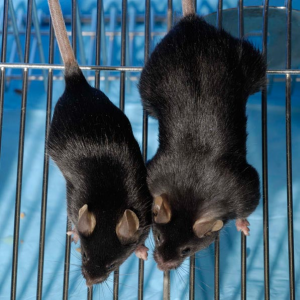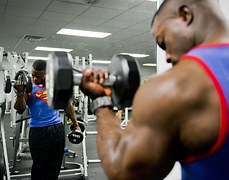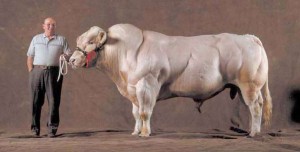You adhere to a strict workout schedule and routine. You are equally meticulous about what you eat, and you always get enough rest. It’s practically a religion with you but, regardless of the progress you make, you still want to see more muscular growth. Maybe it’s just not in your genes…but what if it could be?

Ever wished for the genetic wildcard that would build crazy-lean muscle without giving your skin a greenish hue?
Even people who aren’t comic-crazed know the story of Bruce Banner, aka, the Hulk. It wasn’t the radiation from the Gamma Bomb that caused him to transform into the super-muscular Hulk, though that was the activating element. Instead, it was a genetic factor he carried, possibly passed on from his father, that kept the radiation from killing him and set the stage for his frequent, adrenalin-driven metamorphoses.

Manipulating the myostatin gene in mice results in super rodents who are naturally muscular and strong without having to work out.
So here is the point: there actually is a genetic factor that can be manipulated, and the muscular growth results are essentially on comic book and science fiction level. Back in 1997, scientists studying cell growth discovered a gene that controls muscular growth in animals, including humans. At the time, the gene had not been identified, but it has been come to be known as the myostatin gene. Everyone has them, and they limit muscle growth by releasing a protein into the body. The really interesting thing the researchers discovered was that knocking out the gene in embryonic mice resulted in literal mighty mice–rodents that were visibly muscular and exhibited increased strength. Additionally, inhibiting myostatin appears to only affect skeletal muscle and hasn’t shown any effects on the heart or organs.
Was that what happened to Bruce Banner? Who can say? Anything is possible in comics. But since the discovery of the myostatin gene and its role in muscle development, tons more research has been done. Of course, it shows huge promise for the treatment of muscle-wasting diseases such as muscular dystrophy, but you know the bodybuilding world is just as interested as medical researchers are. How great would it be to be able to turn off the myostatin gene like flipping a switch when you hit a plateau?
For years, ethics and morality stood in the way of human experimentation until, in 1999, nature did the experiment for us. Scientific American briefly documents the case of a baby born in a German hospital who displayed noticeably well-developed muscles. Straight from the womb, the baby boy looked as if he had been hitting the gym for a decade or more. Familiar with the myostatin gene research, pediatric neurologist Markus Schuelke and colleagues decided to find out if there was anything abnormal about this particular baby’s myostatin genes.
Turns out, both copies of the gene were inactive, so the baby wasn’t producing any myostatin at all. On top of that, the baby’s mother also displayed a natural muscularity, so the doctors tested her, too. Only one of her myostatin genes was “turned off,” so it is suspected that the baby’s father also had a myostatin gene mutation, though it appears that no testing was done on him. However, upon a closer look at the mother’s family, it was discovered that the men were extraordinarily strong, as in being able to easily lift 300+ pound stones strong. The bottom line is that the effects of the genetic mutation discovered in the lab have proven to be equally beneficial for humans in the real world.
Knowing all of that starts you thinking. How can I deactivate my myostatin genes so I can gain muscle which will increase my strength and burn fat? The first step is not to resort to pharmaceuticals to get the job done. It might seem like the easiest thing to do, but pharmaceutical companies have not had much success in formulating synthetic myostatin blockers. As of the writing of this post, there may not even be any effective products available. An Internet search will turn up results of supplements and other formulas that are supposed to inhibit myostatin, but you’ll also find an equal number of results discrediting the claims of those products. More importantly, though, is the fact that there could be adverse side effects from putting anything synthetic into your body.
There are natural ways to block myostatin, but they can be imprecise so giving them a try is essentially like conducting your own research. No harm in that, but just don’t be disappointed if you don’t gain 40 percent muscle mass in a month. You are probably already doing the two things Flex online recommends, but you will probably have to tweak your approach.

Pushing yourself in intense resistance workouts is an effective way to naturally control myostatin for muscle and strength gains.
The first thing Flex points out is that weight training is an effective natural myostatin suppressor. When you challenge your muscles enough, your body has some repair work to do so it naturally reduces production of myostatin to allow your muscle cells to rebuild. A 2004 study published in Medicine and Science in Sports and Exercise found that intense resistance training caused a decrease in serum myostatin levels, resulting in strength and muscle mass gain. So, it’s not enough to work out–which in itself is a beneficial activity. However, if you want to block myostatin production in your body to gain muscle size and strength, you have to work out intensely enough to get sore, to feel it.
Diet is the second factor that can affect myostatin production, but this is where it the science becomes really vague. It is not known exactly how or to what degree diet affects myostatin. Some animal studies have shown that restricting calories is effective for inhibiting myostatin, and there may be some benefits from an alkalinized diet, but there isn’t much conclusive evidence to guide the way when it comes to the diet part of controlling myostatin.
As anticlimactic as it may seem, if you are working out, eating healthy, and getting sufficient rest, you are already doing the right things for building muscle. Getting excited about it again will go a long way in helping get you past a plateau. Knowing that your workout is the key to what you can naturally do to gain some control over your body’s myostatin production is a great motivator. Change up that tired workout, increase the amount of weight you’re pulling, pushing, and lifting, or even try a different form of resistance. All of those things will challenge your muscles and decrease your myostatin levels so you can get back to building muscle.

